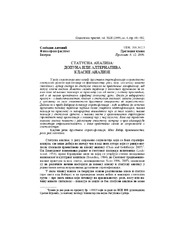Приказ основних података о документу
Statusna analiza - dopuna ili alternativa klasne analize
Status analysis: A complement or an alternative to the class analysis
| dc.creator | Antonić, Slobodan | |
| dc.date.accessioned | 2021-10-12T11:01:26Z | |
| dc.date.available | 2021-10-12T11:01:26Z | |
| dc.date.issued | 2009 | |
| dc.identifier.issn | 0085-6320 | |
| dc.identifier.uri | http://reff.f.bg.ac.rs/handle/123456789/939 | |
| dc.description.abstract | U radu se razmatra veza između društvene stratifikacije i pripadnosti statusnim grupama koje počivaju na državljanstvu, rasi, polu, ili načinu života (potklasa). Autor smatra da statusna analiza ne predstavlja alternativu, već dopunu klasne analize. Životni izgledi pojedinca u današnjim društvima ne zavise samo od njegovog položaja na tržištu (ili od mesta u sistemu proizvodnje), već i od njegove pripadnosti određenoj statusnoj grupi. Otuda je veberijanski pristup - s dvodimenzionalnom, klasnom i statusnom analizom, svakako uspešniji u suočavanju sa svim složenostima društvene stvarnosti od marksističkog. Dodamo li i treću Veberovu dimenziju stratifikacije - moć, videćemo da se tačan društveni položaj pojedinca najbolje može utvrditi identifikacijom: njegove pozicije na tržištu (i materijalnog ekvivalenta koji iz toga ishodi); njegove pozicije u statusnim grupama; i njegovog mesta u organizacionim strukturama (pripadnost nekoj organizaciji i položaj koji u njoj zauzima). Kako ovu trodimenzionalnu analizu povezati u jedinstvenu analitičku matricu i kroz odgovarajuće indikatore operacionalizovati, i dalje predstavlja izazov za istraživače i statističare. . | sr |
| dc.description.abstract | The author discusses the relation between stratification and belonging to the status groups based on citizenship, race, gender or lifestyle (underclass). The author claims that the status analysis is not an alternative, but a complement to the class analysis. The life prospects of individuals in today's society depend not only on their position in the market (or in the system of production), but on their membership of a particular status group as well. Hence the Weberian approach - with two-dimensional, class and status analysis - is certainly more successful in dealing with all the complexities of social reality than the Marxist one. Therefore, if we add the third dimension of the Weber's stratification scheme - power, we can see that the exact social position of the individual could be determined the best by identification of its: position in the market (and the financial equivalent of the outcomes from it); position in a status group; and position in organizational structures (belonging to an organization and position that it occupies). Landowner or wage earner, citizen or immigrant, union activists or non-member, each of these positions mean a position either higher or lower on the stratification ladder. How this three-dimensional approach could be united into a single analytical matrix, and how could successful operationalization of it through appropriate indicators be made, still remains a challenge for researchers and statisticians. . | en |
| dc.publisher | Sociološko društvo Srbije, Beograd | |
| dc.relation | info:eu-repo/grantAgreement/MESTD/MPN2006-2010/149005/RS// | |
| dc.rights | openAccess | |
| dc.rights.uri | https://creativecommons.org/licenses/by-sa/4.0/ | |
| dc.source | Sociološki pregled | |
| dc.subject | rod | sr |
| dc.subject | rasa | sr |
| dc.subject | potklasa | sr |
| dc.subject | Maks Veber | sr |
| dc.subject | državljanstvo | sr |
| dc.subject | društvena stratifikacija | sr |
| dc.subject | underclass | en |
| dc.subject | social stratification | en |
| dc.subject | race | en |
| dc.subject | Max Weber | en |
| dc.subject | gender | en |
| dc.subject | citizenship | en |
| dc.title | Statusna analiza - dopuna ili alternativa klasne analize | sr |
| dc.title | Status analysis: A complement or an alternative to the class analysis | en |
| dc.type | article | |
| dc.rights.license | BY-SA | |
| dc.citation.epage | 502 | |
| dc.citation.issue | 4 | |
| dc.citation.other | 43(4): 481-502 | |
| dc.citation.rank | M24 | |
| dc.citation.spage | 481 | |
| dc.citation.volume | 43 | |
| dc.identifier.doi | 10.5937/socpreg0904481A | |
| dc.identifier.fulltext | http://reff.f.bg.ac.rs/bitstream/id/2463/936.pdf | |
| dc.type.version | publishedVersion |

